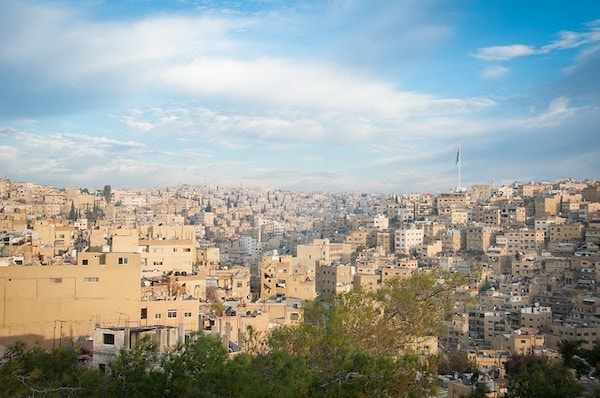Closely attending to Muslim theorizations provides an opportunity for social scientists to stop asking such questions as ‘what is so Islamic about Islamic humanitarianism?’ or ‘do Muslim humanitarians really work for humanity?’—not least because such questions are methodological traps.
Over the course of my fieldwork in Jordan I spent many hours with Zayed Hammad, the director of the Jam‘iyyat al-Kitab wa-l-Sunna (The Association of the Book and the Prophetic Practice). The organization itself, established in 1993 as a cultural association, has a history that reflects key developments in the Islamic Revival. Shaykh Zayed long distinguished its activism from other wings of Salafism in the country (Wagemakers 2016). But then came the Syrian crisis (al-azmeh al-suri), as it is widely referred to, and he expanded the scope of his organization toward a humanitarian mission. The magnitude of the displacements resulting from Syrian regime brutality and the consequent militarization and splintering of the opposition factions is well known. According to UN numbers there are about 666,000 Syrians formally registered as refugees in Jordan (UNHCR 2019), though the total number of displaced Syrians in the country was often described to me as over a million.
The Jam‘iyyat al-Kitab wa-l-Sunna is one of the Jordanian Islamic charities most active across the domains of refugee support (cash support, shelter provision, educational programs…). In 2013, for instance, they distributed USD 50 million of aid to 350,000 refugees (over 45,000 families) (Ababsa 2015). Although it had scaled back its activities as of my last interviews in February 2019, due mostly to donor fatigue (a common story across all kinds of relief programs in Jordan—in Lebanon and Turkey as well), they continue to pay for cancer treatments and host orphans, teach Quran and distribute food. I always met Shaykh Zayed in his office, where I would ask him questions over tea (usually just for me, because he would be fasting), punctuated by phone calls, often from individuals asking if there was any aid available, which he would direct to one branch or another of the organization—or, most frequently, would reply that they should quietly come to the office and receive 20 JOD (40$) for immediate expenses without telling anyone where they got it.
In our very first meeting (February 2018), when I described my research topic as being the relationship between religion and humanitarianism, Shaykh Zayed immediately forwarded to me something he had already prepared on the topic, which he said would answer my questions. It is a PowerPoint presentation of nearly thirty slides, some more detailed than others, titled “The Work of Islamic Charitable Organizations in the Light of Islamic Shari‘a and International Humanitarian Law” (‘amal munazzamat al-khayriyya al-islamiyya ‘ala daw’ al-shari‘at al-islamiyya wa-l-qanun al-duwali al-insani). The presentation begins with Quran 21:107: “And We have not sent you (O Muhammad) except as a mercy to the worlds.” The presentation glosses ‘world’ in a few ways: the twentieth-century Egyptian scholar Muhammad al-Sha‘rawi cites the classical definition of the “world” (‘alam) to which the Prophet brought mercy as being “everything other than God”, namely the realms of angels, jinn, humans, even animals, plants, and minerals; the twentieth-century Syrian scholar Ratib al-Nabulsi comments that the Prophet was sent as a mercy to the faithful and to infidels and to hypocrites, to all the children of humanity, men, women, children, and to birds and animals alike.
Subsequent slides enumerate authorities and roots of humanitarian principles (mabadi’ insaniya): first the fitra, the divinely established human nature; then the various religions (adyan); then national and international laws; and finally principles of utility or public benefit. The next slide lists ethical principles for humanitarian work (humanity; sanctity; responsibility and legitimacy; dignity). The presentation proceeds like this, establishing the conceptual space of humanitarianism, before shifting into a comparative mode: one slide has two columns, the first defining international humanitarian law and the second defining international humanitarian law in Islam. There is little substantive difference between the two columns; each is directed toward human protection and the maintenance of human dignity, but they invoke different archives (international treaties/conventions and shari‘a, respectively). The next slides abandon this explicitly comparative effort, instead offering Islamic reasons for specific humanitarian principles and then discussing the purpose and types of charitable action.
The comparative mode returns later, but curiously the vector of the comparison has shifted: it now first lists the terms of charity in Islam, then gives their conceptual equivalent in ‘the West’ (in English translation), and then provides an Arabic translation of that concept. What I find interesting is not only that the direction of the comparison has changed (from an Islamic term to a Western one, rather than the other way around) but also that there are three columns, not two, and that some of these translations end up more awkward than others in passing from a regime of virtues (e.g. al-rifq bi-l-hayawan: kindness to animals) to a regime of rights (‘protection and promotion of animal rights’). The Islamic practice of ‘enjoining good and forbidding evil’ (al-amr bi-l-ma‘ruf wa-l-nahy ‘an al-munkar), for instance, is rendered into English as ‘civic action’, and then into Arabic again as al-mumarisa al-muwatiniyya. And this is explicitly conducted as a translation between “Islam” and “the West” (the international humanitarian apparatus is explicitly figured as Western).
What makes Muslim humanitarian practice distinct, Shaykh Zayed concluded in conversation when we discussed this presentation, is that it affirms the primordial nature (fitra) of humanity.
And because the principles and practices of Muslim humanitarianism accord with this nature, being also a means of upholding personal and collective duties to God, it urges (haththa) humanity, that is, it develops the capacity of humanity. Other types of humanitarianism are also based in this human nature (fitra), he clarified, but disproportionately focus on beneficiaries or benefactors, or exploit beneficiaries along the way, or are driven by enthusiasm and not a kind of moral seriousness. Islamic activists also fall into these pitfalls, he admitted. But they can take recourse to the tradition of Islamic moral reasoning, in order to avoid them.
Amira Mittermaier (2019) has recently described Islamic practices of giving in postrevolutionary Cairo as exhibiting a “nonhumanitarian ethics”. Such practices bypass the humanitarian fetish for spectacular suffering, she writes, for such people are moved to act by a divinely-imposed obligation (not simply by compassion for a generic suffering Other). Nor is the scene of such charity determined by the asymmetrical relationship between benefactor and beneficiary, for God is a mediating third party who makes the relation between ‘benefactor’ and ‘beneficiary’ reversible (in that the ‘beneficiary’ is the one who occasions the practice/possibility of the ‘benefactor’s’ piety in the first place). While Shaykh Zayed’s presentation takes such an ethics for granted, it also engages the secular grammar of humanitarian practices while attempting to re-locate/re-ground Muslim humanitarian work. I would thus suggest that we understand his effort as addressing (or itself interpellating/articulating) an Islamic counterpublic within the space of that humanitarian world—thinking counterpublic not, with Nancy Fraser, as a kind of subaltern opposition to bourgeois discourse, but rather with Charles Hirschkind (2006) as a set of discursive practices which structure the rationalities, sensibilities, and aims of the Islamic reform movement.
This post has begun elaborating the theorization of ‘humanitarianism’ of the director of one charitable organization in Jordan. I am not suggesting that it provides a model for Muslim humanitarianism writ large. But we should consider this theorization seriously, both for what it does for Shaykh Zayed and for what it does for the anthropology of humanitarianism. For Shaykh Zayed, the PowerPoint has a pedagogical purpose, directed as it is toward teaching Muslim humanitarians (including Islamist activists, islamiyun) the form and function of charitable practice in confronting conditions of desperation and dispossession. For social scientists, however, it should also solicit a different kind of reflection. Islamic charitable organizations like this one are providing massive amounts of aid to refugees and others, in Jordan and well beyond (e.g. Benthall and Bellion-Jourdan 2009), especially given the funding shortfalls for which international aid programs are notorious. All too often, the academic literature on such groups either reflects the normative secularity of humanitarian policy (and so is anxious that these groups are at once too religious and too political, according to the conditions of legibility set by the secular grammar of the international humanitarian industry: Ager & Ager 2011), or rushes to fold such groups under the important anthropological critique that humanitarianism produces spaces of exception, divides ‘humanity’ into a hierarchy of benefactors and beneficiaries, and takes disasters, epidemics, or conflicts as occasions for practicing a new type of government (Ticktin 2014). What is lost in both these critical moves is consideration of precisely how such groups articulate their claims.
The theorization of humanitarianism offered by Shaykh Zayed provides an opportunity for social scientists to stop asking such questions as ‘what is so Islamic about Islamic humanitarianism?’ or ‘do Muslim humanitarians really work for humanity?’—not least because such questions are methodological traps. One of the insights of the anthropology of secularism has been that if anthropologists approach contemporary Muslim practices with a view to separating what is properly secular from what is properly religious, then they have already committed themselves to a secularist analysis. (Muslims themselves, of course, regularly ask the question of what is properly Islamic, but in doing so they are engaging their own discursive tradition with their own authoritative criteria, which are not shared with the social scientist—who presumably is not seeking to intervene into that tradition.) And one of the insights of the anthropology of Islam has been that identifiably secular logics (here, e.g., rendering al-amr bi-l-ma‘ruf as ‘civic action’; invoking the concept of ‘humanity’) can rearticulate Muslim forms of life, without these somehow becoming less Islamic for the anthropologist. Contemporary Muslim humanitarianism is certainly marked by neoliberalism and globalization: we live in a single, interconnected world, as Talal Asad repeatedly reminds us.
But the acts of translation practiced by Shaykh Zayed in theorizing “in the light of shari‘a and international law” should suggest certain methods of comparison and indifference, antagonism and engagement, which the anthropologist might also adopt in considering the form and function of Muslim humanitarianism today.
References
Ababsa, Myriam. 2015. “De la crise humanitaire à la crise sécuritaire. Les dispositifs de contrôle des réfugiés syriens en Jordanie (2011-2015).” Revue européenne des migrations internationales [online] 31, nos. 3-4, http://journals.openedition.org/remi/7380.
Ager, Alastair and Joey Ager. 2011. “Faith and the Discourse of Secular Humanitarianism.” Journal of Refugee Studies 24, no. 3:456-472.
Benthall, Jonathan and Jerôme Bellion-Jourdan. 2009. The Charitable Crescent: Politics of Aid in the Muslim World. 2nd ed. IB Tauris.
Hirschkind, Charles. 2006. The Ethical Soundscape: Cassette Sermons and Islamic Counterpublics. Columbia University Press.
Mittermaier, Amira. 2019. Giving to God: Islamic Charity in Revolutionary Times. University of California Press.
Ticktin, Miriam. 2014. “Transnational Humanitarianism.” Annual Review of Anthropology 43:273–289.
UNHCR 2019. “Registered Syrians in Jordan.” May 15.
Wagemakers, Joas. 2016. Salafism in Jordan: Political Islam in a Quietist Community. Cambridge University Press.
Featured image by Akshay Paatil (courtesy of Unsplash.com).









